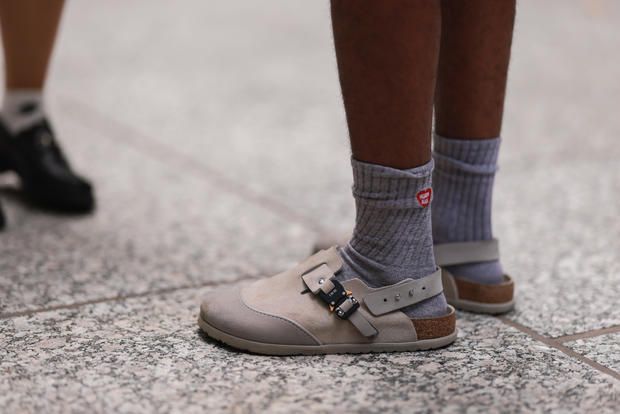Birkenstock, the 250-year-old German brand best known for its flat, orthopedic sandals embraced by hippies and grandparents, is no longer the antithesis of high-fashion.
Today, it’s a multibillion dollar company popular among celebrities and style influencers, that has collaborated with the world’s top luxury fashion houses. It also went public Wednesday.
How did it get here?
The company’s roots as a comfort brand committed to quality and integrity have a lot to do with its success. The family-run business began by making and selling flexible insoles that are the same footbeds in Birkenstocks sold today.
According to Birkenstock, the footbeds encourage “proper foot health by evenly distributing weight and reducing pressure points and friction.”
“Birkenstock remains uncompromising when it comes to prioritizing foot health over looks. It is a brand that has always been about function,” said Maggie Sause, director of Go To Market at Red Antler, a branding agency.
“You wore them in secret”
Sure, they were comfortable, but for decades the sandals were derided as “ugly” and reserved for “hippies, grannies and tourists,” according to Sause.
Even some fans of Birkenstocks were embarrassed by their appearance.
“I’ve been wearing Birkenstocks since I was in college when they were 100% hippie-dippie. You wore them in secret in the dorms with your pajamas when you weren’t seen. It was like wearing orthopedic shoes,” said Quynh Mai, founder and CEO of Qulture, a digital creative agency. Mai herself owns six pairs of Birkenstocks, including shearling-lined styles she wears in the wintertime.
Writer and editor Nicole Anderson, who currently owns three pairs said that when she was younger, she “hated Birkenstocks with a passion.”
“I thought they were the ugliest sandals because they were always the look of the hippie with a hacky sack, so they never appealed to me,” she said.
Anderson became a convert within the past decade when the company started coming out with sleeker styles in different colors and materials and now finds them to be “nice looking and comfortable.”
According to Birkenstock, the average customer owns 3.6 pairs of its shoes.
Embrace of the “ugly”
Fortunately for Birkenstock, its commitment to quality more recently coincided with a trend of rejection of traditional beauty norms, particularly among younger generations. That can mean deliberately dressing in a way that would customarily be considered unattractive, or openly embracing “ugly” styles.
“We have seen this trend over the last decade of all the fashion girlies and models stepping out in what were traditionally determined to be ugly shoes designed for extreme comfort,” Strause of Red Antler said.
Birkenstock also collaborated with fashion houses Dior, Manolo Blahnik, Rick Owens and others, effectively tapping into those companies’ brand equity and acquiring new customers.
Jeremy Moeller/Getty Images
“It opened the door for Birkenstock to an entirely new audience. It gave them permission to retail not just at REI but also at Mr. Porter. New fans may have come to the brand through collaborations, but the reasons for their popularity are always comfort and durability,” Strause said.
As a result, fashionistas in Milan are as likely to wear them as a 75-year-old Vermont man “doing a co-op run,” Strause said.
Opposed to paid brand ambassadors or influencers, when true arbiters of style — including models, fashion stylists, photographers’ assistants and creative directors — started wearing the shoes, they helped drive the brand’s popularity.
“Their rise dovetailed with rise of Instagram where regular cool people became influencers and influenced fashion more than celebrities,” Mai said.
Once Birkenstock had won over the tastemakers, regular consumers followed.
“If the coolest person in the room was wearing them, it gave regular people license to wear it as well,” Mai said.
Edward Berthelot/ Getty Images
Comfort first
It helped too that the COVID-19 pandemic helped nudge style preferences over to the comfort end of the spectrum.
Wearing comfortable clothing, a form of self-care, has remained en vogue.
“I would argue that Birkenstock entered the fashion lexicon before then, but the pandemic had a hand in supercharging this obsession with comfort. We were all forced to take a couple of years out from wearing fashion-first clothing and footwear,” Strause said.
Mai agrees that the brand benefited, in some senses, from the pandemic.
“It was a moment where people were embracing the ugly as a way of rejecting the mainstream and this notion of perfection. This cultural moment was happening around COVID that has lasted and Birkenstock rode that,” Mai said.
Birken-stock
In its debut on Wall Street Wednesday, Birkenstock started trading at $41 per share, more than 10% lower than its initial public offering price of $46 per share — which valued the company at $8.64 billion, AP News reported.
It remains to be seen how Birkenstock will fare as a public company, under pressure from analysts, investors and shareholders.
“Once you are listed, you have to achieve specific numbers for quarters during the year, so some formulas they have used over the past 250 years could change,” said NYU professor Thomai Serdari, who studies premium legacy companies.
“I want to see them maintain their strength and make sure they don’t compromise the quality of the product,” she said. “If they succumb to the industry pressure, they’ll dilute something that has survived for many centuries.”


